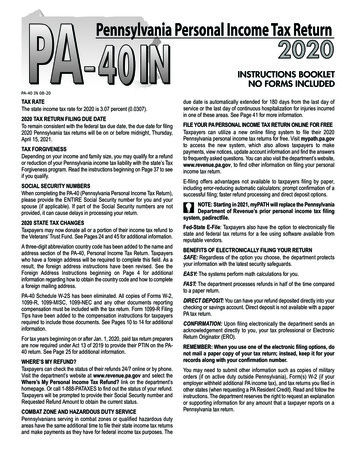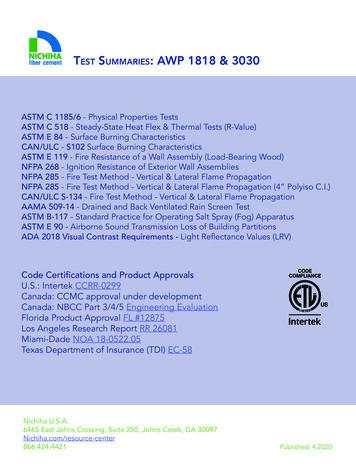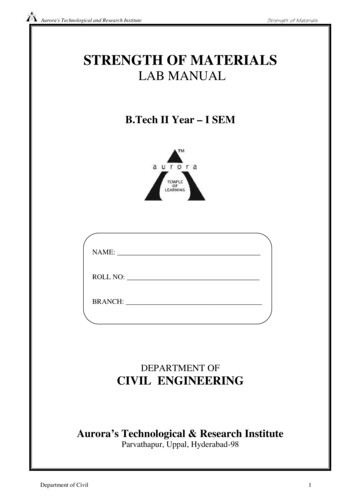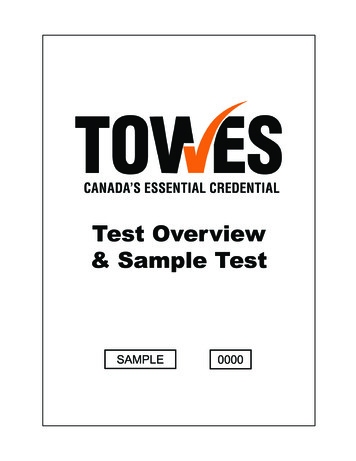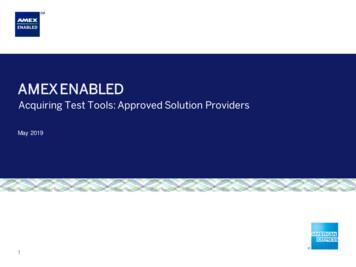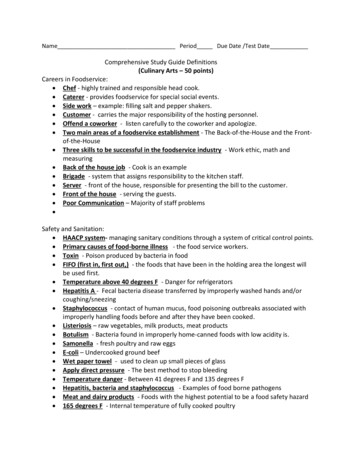
Transcription
Name Period Due Date /Test DateComprehensive Study Guide Definitions(Culinary Arts – 50 points)Careers in Foodservice: Chef - highly trained and responsible head cook. Caterer - provides foodservice for special social events. Side work – example: filling salt and pepper shakers. Customer - carries the major responsibility of the hosting personnel. Offend a coworker - listen carefully to the coworker and apologize. Two main areas of a foodservice establishment - The Back-of-the-House and the Frontof-the-House Three skills to be successful in the foodservice industry - Work ethic, math andmeasuring Back of the house job - Cook is an example Brigade - system that assigns responsibility to the kitchen staff. Server - front of the house, responsible for presenting the bill to the customer. Front of the house - serving the guests. Poor Communication – Majority of staff problems Safety and Sanitation: HAACP system- managing sanitary conditions through a system of critical control points. Primary causes of food-borne illness - the food service workers. Toxin - Poison produced by bacteria in food FIFO (first in, first out,) - the foods that have been in the holding area the longest willbe used first. Temperature above 40 degrees F - Danger for refrigerators Hepatitis A - Fecal bacteria disease transferred by improperly washed hands and/orcoughing/sneezing Staphylococcus - contact of human mucus, food poisoning outbreaks associated withimproperly handling foods before and after they have been cooked. Listeriosis – raw vegetables, milk products, meat products Botulism - Bacteria found in improperly home-canned foods with low acidity is. Samonella - fresh poultry and raw eggs E-coli – Undercooked ground beef Wet paper towel - used to clean up small pieces of glass Apply direct pressure - The best method to stop bleeding Temperature danger - Between 41 degrees F and 135 degrees F Hepatitis, bacteria and staphylococcus - Examples of food borne pathogens Meat and dairy products - Foods with the highest potential to be a food safety hazard 165 degrees F - Internal temperature of fully cooked poultry
Wash their hands for 20 seconds or more - Number 1 hygiene rule for foodserviceworkerDry large pots and pans - place upside down/air dryTemperature of below 40 degrees F – Cook leftovers rapidlySmall cut on the hand - wash it, put on a bandage, wear single use gloves.Cross-contamination - microorganisms move from one food to another.Mise en place - to prepare to workOrder of 3 compartment sink – rinse/scrape and wash and rinse then air dryMeasurements/Conversions: When increasing the number of portions yielded by a recipe goes from 100 to 400. Inthe recipe 2 pints would increase - to 4 pints. A gallon of potato salad - will yield 32 ½ cup servings. Recipe conversion - The ratio of ingredients should remain the same Yield - How much food a recipe makes Figure cost per serving - figured by the cost of the food divided by the number to beserved. You have 7 cups, you decrease the yield by one-half - 3 ½ cups. How many 1 cup servings are in a gallon? - Sixteen 1 cup servings. How many times must a recipe be increased to serve 60 people if the yield is threepints and the portion is 1 cup? - 6 cups X 10 60Equipment Boning knife – disjoint a chicken Convection oven – cooks with a fanCooking Terms and Techniques To soften the top of bread - Brush milk on top Standardized - The recipes that food services establishments rely on Marinating – Soaking food in an acid/oil mixture to help tenderize Baste – Brush or pour liquid over food as it cooks Dredge – Coat with four or other fine substance Dice – Cut carrots and onions into ¼ inch squares Julienne – Cut into thin, match stick size pieces Garnish – be suitable so it complements the main food item Mirepoux – Sachet of mixture of chopped vegetable and herbs One egg white – substitute for 2 eggs Saute – brown quickly in small amount of fat Julienne, minced, chop, batonnet – basic knife cutting techniques Steamer table – keeps food warm until served Braising and stewing – combination cooking method
Fruit and Vegetables Prevent oxidation or browning – dip in pineapple juice Stop oxidation of potatoes – cover in cold water Keep fruits fresh – dip in acid 2 fruits to control enzymatic browning – apples and peaches Steaming - reduces nutrient loss of vegetablesSalads 11Recipes Standardization in restaurants – Make sure food is always prepared the same way Standard portions – Everyone gets exactly the same sized servingAcronyms 11Breads Sugar helps to tenderize, add flavor, aids in browning Flour – forms the framework Liquid – Moistens other ingredients, activates leavening agents Salt – Brings out the flavor of other ingredients Leavening agent – makes the batter or dough rise, become light and porous Shortening – Provides tenderness Baking powder – most common leavening agent in quick breads Basic ingredients in quick breads - flour, liquid, leavening agent Preserve quick breads – wrap/store at room temperature Gluten – elastic framework, stretches and holds gas bubbles formed by leavening agent Dough not kneaded properly – becomes heavy and small Cause of yeasty taste – proofed too long Fermentation – process to allow the bread to rise Pour batter example – crepe Crumb – texture of inside the bread Soften the top of bread – brush milk on top Whole grain – part of daily food plate Steam – leavening agent for cream puffs and éclairs Pour batter 1 part flour: 1 part liquid Drop batter – 2 part flour:1 part liquid Soft dough – 3 part flour:1 part liquid Lean yeast dough – little sugar/ fat
Rich yeast dough – extra sugar and fatProtein and Meat Rib and loin – most tender wholesale cup of beef Complete protein in vegan diet – beans and rice Roasting is what cooking method – dry heat Sear – brown meat quickly over high heat Au jus – serve meat with its own juices Steaks – cross section of dressed fish Prime – highest grade for beef, veal, lamb Lacto-vegetarian – no meat/ yes milk products Lacto-ovo-vegetarian – no meat/ yes milk and egg products Vegan – no meat products
Food Service/Culinary ArtsTest Number: 345CTE Skill Certificate Test Performance DocumentationThis document must be submitted to the test coordinator at the end of testing each trimester/semester.Instructor’s Name: Course: Food Service/Culinary ArtsSchool: Test Number: 345# Students in course: Date:# Students tested:# Students who passed the online test at or above 80%:# Students who passed the performance objectives at or above 80%:This is to verify that the students marked YES on performance accomplished the following performanceobjectives at or above the 80% (moderately to highly skilled) level.1. Research a career in the food service industry using multiply sources (personal interview, internet,utahfutures.org, periodicals etc.) and present your findings.2. Demonstrate appropriate food handler safety and sanitation procedures. Proper hand washing, uniform/apron use, hair restraint and covering, avoiding crosscontamination, and proper food storage.3. Demonstrate proper workplace safety procedures Appropriate footwear, proper lifting, safe knife and equipment use, and other proper kitchenprocedures for safety.4. Demonstrate proper mise en place and clean up. Gather equipment and supplies; pre-measure ingredients; peel, cut and chop food as needed.5. Demonstrate appropriate use and care of food preparation equipment Hand tools, knives, small appliances, and large appliances and etc.6. Plan the menu for a complete meal, then prepare and serve this meal. Menu must be nutritionally balanced, have proper portion sizes and be aesthetically pleasing. The production and portion costs need to be calculated Meal must include a starter (soup, salad, or appetizer), entrée (protein, starch, sauce andvegetable), and dessert. Service included and appropriate table setting and proper customer service.7. As part of a group participate in planning preparing and serving a meal or food items to customers orguest. Follow up by analyzing the process, profitability, and communication and teamwork.8. Plan, calculate cost, prepare and present a bakery item for a minimum of 75 people.Each performance is documented and kept on file by the teacher for two years.(Check the documentation method used) Class period summary score sheet Recorded and identified in the class grade bookInstructor’s Signature: Date:
Strands & StandardsFOOD SERVICES / CULINARY ARTCOURSE DESCRIPTIONStudents will be trained for career opportunities in the food service/culinary artsindustry. Students will have the opportunity to learn and practice safety andsanitation procedures, and use and maintain commercial food service equipment.They will perform quantity food preparation as it relates to catering, bakery,restaurant, hospitality, and fast food business operations. This course willstrengthen comprehension of concepts and standards outlined in Sciences,Technology, Engineering and Math (STEM) education. Student leadership andcompetitive events (FCCLA) may be integrated into this course.License TypeCTE and/orSecondary Education 6-12Required EndorsementFACS General Composite orCTE License only – FoodServices/Culinary ArtsIntended Grade Level: 11-12Units of Credit: 1.00CIP Code: 20.401Core Code: 34.01.00.00.170CE Core Code: 00.00.00.00.000Prerequisite: Food andNutrition I & IISkill Certification: #345Test Weight: 0.0Revised May 2016Page 1 of 24
STRAND 1 Students will discuss the food service industry including; history,trends, segments, career options and required employment skills.Vocabulary:CareerWork ethicStandard 1 Identify and discuss history and trends in the food service industry.1. Explain the history of food service.a. Include: Auguste Escoffier – considered the father of modern cuisine. During thelate 1800 he simplified, updated and popularized classical French cookingmethods and organized kitchen management.2. Identify current trends and their influence on food service industry.a. Government regulations and safety, cycles and popularity, media, and currentevents3. Explore cultural influences in the food service industry.Standard 2 Identify various food service industry segments such as quickservice, family dining, fine dining, catering, and institutional/non-commercial foodservice.1. The two main food service segments are classified as commercial and noncommercial.a. Non-commercial includes: healthcare, education, military, charity andcorrections.b. Commercial includes: restaurants, caterers, lodging, travel, concessions, andretail.i. Identify various types of restaurants including quick service and fullservice.Standard 3 Identify various career opportunities and educational requirements.1. Identify various careers and training opportunities involved in culinary/food serviceindustry. (utahfutures.org recommended)Standard 4 Apply employability skills1. Develop a basic understanding of the employability skills (see the CTE website for aninteractive frame work and resources http://cte.ed.gov/employabilityskills/ )a) Applied Knowledgei) Critical Thinking (problem solving)ii) Applied Academic Skills (including math)b) Effective Relationshipsi) Interpersonal Skills (including team work, cooperation, and communication)(1) Majority of problems between staff are caused by poor communication.ii) Personal Qualities (honesty/integrity, initiative, positive attitude, loyalty,dependability, respect, punctuality, working independently, and anticipating needsc) Workplace Skillsi) Technology Useii) Systems Thinkingiii) Communication Skills (appropriate dress and language)iv) Information UseFood Service/Culinary ArtsRevised May 2016
v) Resource Management (including time)PERFORMANCE OBJECTIVE 1Research a career in the food service industry using multiply sources (personalinterview, internet, utahfutures.org, periodicals etc.) and present your findings.STRAND 2Students will discuss the importance of sanitation and foodsafety in the flow of food.Vocabulary:PathogenCross ContactCross ContaminationCritical Control PointTCS (Time and Temperature Control for Safety)Standard 1 Identify the steps in the flow of food including purchasing, receiving,storage, preparation, cooking, holding (hot/cold), cooling, reheating, and serving*STEM (Science)1. Explain the purpose of the HACCP system (Hazard Analysis Critical Control Point).a. A way to ensure keeping food safe through a system of identifying andmonitoring critical control points.2. Discuss methods of purchasing, receiving, and storage.a. Purchase from an approved reputable vendor.b. FIFO (first-in first-out) rule – means the food that has been in the holding areathe longest will be used first.c. Refrigerator and freezer temperatures (Refrigerator: 41 degrees or lower;Freezer: 0 degrees or lower.d. Food storage and cleaning supply storage must be separateStandard 2 Identify standards of personal grooming and hygiene. *STEM(Science)1. Establish and follow procedures to prevent human contamination (food handler permitrequirements).2. Identify business standards for personal hygiene.a) Wash hands with soap and warm water- minimum 20 sec. and dry with single use papertowelb) Wash hands after using the restroom, sneezing, coughing, or touching face or hairc) Wash hands before and after handling raw meat, poultry and eggs.d) Single use gloves shall be used for only one task such as working with ready- to- eatfood or with raw animal food, used for no other purpose, and discarded when damagedor soiled, or when interruptions occur in the operation.e) Wear bandages and gloves or other protective barriers over any cuts or open sores.f) Anyone preparing food shall wear hair restraints such as hats, hair coverings or nets,beard restraints and clothing to effectively keep their hair from contacting exposed food.g) All food service workers need to wear proper, clean attire, including chef coats and/oraprons. Change dirty attire – bacteria could be on it that can contaminate food.h) Any activity involving eating, drinking or chewing gum needs to occur in a designatedarea away from food preparation areas.i) When tasting food, use clean spoon only once.Food Service/Culinary ArtsRevised May 2016
Standard 3 Identify proper sanitation techniques used with tools, equipment,and surfaces. *STEM (Science)1. Discuss the order used when washing and sanitizing dishesa) 3-compartment sink dishwashing order: rinse and scrape, wash, rinse, sanitize and airdry.2. Containers for storing and mixing food are stored upside down.3. Differentiate between cross-contact and cross-contamination.a) Cross- contact happens when one food containing allergens comes in contact with asurface or food thereby posing a hazard for persons having that allergy.b) Cross- contamination is the human transfer of pathogens from one surface or food toanother.Standard 4 Identify the factors contributing to food-borne contamination, illness,and prevention strategies. *STEM (Science)1. Discuss general concepts of food-borne illness.a) Food-borne illness – results from eating foods contaminated with pathogens.b) General conditions for bacterial growth – food, acidity, time, temperature, oxygen,moisture, (FAT TOM)c) Contaminated food does not always have an off odor or flavor so it looks and smellsnormal.2. Identify food borne illnesses: botulism, e-coli, Hepatitis A, salmonella, staphylococci,listeriosis, norovirusa) Botulism – associated with any anaerobic environment, i.e., canned foods, garlic /herband oil mixtures, and foil wrapped baked potatoesb) E-coli – usually found in undercooked ground beef, unpasteurized milk, fruit juices, freshfruit, and vegetablesc) Hepatitis A – a virus found in an infected person’s fecal matter transferred by humancontact usually through improper hand washing.d) Salmonella – often found in fresh poultry and raw eggse) Staphylococcus – spread through human contact to food sources especially dairy andnon-cooked ready to eat foods.f) Listeriosis – usually found in ice machines, and TCS foods served cold.g) Norovirus-is similar to Hepatitis A and is linked with contaminated water and ready to eatfoods.h) Food borne illness symptoms that exclude a worker from handling food include:i) Sore throat with feverii) Jaundiceiii) Diarrheaiv) Vomitingv) Open and infected soresi) Food handlers need to be symptom free for 24 hours before handling food.3. Discuss prevention strategies.a) Large majority of food-borne illness can be prevented by avoiding cross contamination.b) When in doubt throw it out. Do not taste or use. Don’t use bulging cans.c) Frequently clean and sanitize work surfaces, i.e. countersd) Clean and sanitize cutting boards, dishes, tools, etc., after preparing each food item orevery four hours of continuous use.e) All TCS foods need to be covered and stored in the refrigerator with a label including ause by date.f) Food should be stored in the refrigerator according to the final cooking temperature.Food Service/Culinary ArtsRevised May 2016
i)4.5.6.7.Ready to eat foods (RTE) on top and animal products toward the bottom accordingto cooking temperature.g) Never place cooked food on a plate which has previously held raw meat, poultry orseafood without first cleaning and sanitizing the plate.Food should not be in the Danger Zone, (the temperature range of 41-135 degrees), forlonger than 4 hours total from start of preparationDiscuss the importance of cooking to proper temperatures internal food temps - be sure touse a clean and sanitized thermometeri) Seafood, pork, beef, veal, lamb – 145 degreesii) Ground meats (pork, beef, veal, lamb) and eggs – 155 degreesiii) All Poultry (whole or ground) – 165 degreesiv) Reheat temp – 165 degrees (for a minimum of 15 seconds)Discuss the importance of cooling and reheating foods to the correct temperature for thecorrect amount of time using proper equipment.a) Keep hot foods hot and cold foods cold. (Hold hot 135 degrees and above. Cold 40degrees or lower.)b) Thoroughly cool hot foods. Food needs to be cooled below 70 degrees within two hoursand below 41 degrees within four more hours.i) Methods include: Divide large amounts of leftovers in small, shallow, coveredcontainers for quick cooling, ice water baths, and ice paddles.c) Store foods in the fridge and freezer so that the cool air can circulate to keep food safe.Don’t cover shelves or overcrowd.d) Bring sauces, soups etc. to a boil when reheating; heat other TCS leftovers to 165degrees (for a minimum of 15 seconds)Discuss how to correctly thaw foods.a) Safe ways to thaw food include: in the refrigerator, under cold running water, in themicrowave, or as part of the cooking process. Never defrost at room temperature. Ifthawing food in the microwave cook immediately.PERFOMANCE OBJECTIVE 2Demonstrate appropriate food handler safety and sanitation procedures.Proper hand washing, uniform/apron use, hair restraint and covering, avoidingcross contamination, and proper food storage.STRAND 3Apply basic workplace safety and first-aid procedures.Vocabulary:IngestOSHAStrain (ligaments)MSDS sheetSprain (muscles/tendons)ALERT systemStandard 1Students will identify safe work practices1. Identify common workplace/food service injuries/ accidents and their prevention.a) Burns/scaldsb) Cuts/scrapesc) Breaksd) Strains/sprains and contusionse) Firesf) Chemicalsi) IngestedFood Service/Culinary ArtsRevised May 2016
ii) Burnsiii) inhaled2. Identify basic first-aid proceduresa) Choking: treat with the Heimlich (abdominal thrust)i) Do not interfere if the victim is coughing forcefully with a partial airway obstructionb) Treating a burn:(a) First degree burn (cool with cold water)(b) Second degree burn (soak in cool water or cold compress)(c) Third degree burn (cover loosely with a dry, sterile cloth, seek medical help)c) Treat sprains, strains and contusions with RICE (rest, ice, compression and elevation)d) Cuts (for severe wounds, apply direct pressure)e) Allergic reactionsi) Causes are generally one of the main 8 allergens: fish, shellfish, soy, wheat,peanuts, tree nuts, dairy and eggs. Customers must be made aware of any of theseingredients in food.ii) Symptoms include; itching, swelling, hives, respiratory difficulties, rash andheadachef) For chemical accidents see MSDS (Materials Safety Data Sheets) for treatmentrecommendations3. Students will identify the meaning and purpose of ALERT a security and food defensesystem.a) Assure- products received from a safe source and practice food defense, and vehicleslocked/sealed.b) Look- monitor the facility and product security. Pay attention to your surroundings.c) Employees-know facility, limit access to prep/storage, limit visitors and verify credentials,conduct background checks on staff.d) Report- keep information related to food defense accessible, including conductingrandom self-inspections.e) Threats-identify and plan what you will do and who you will contact in the event ofsuspicious activity and/or threat.f) Train employees about the plan and proceduresPERFOMANCE OBJECTIVE 3Demonstrate proper workplace safety procedures and first-aideAppropriate footwear, proper lifting, safe knife and equipment use, and otherproper kitchen procedures for safety.STRAND 4Identify and practice the basic concepts of food production.Vocabulary:Kitchen brigade systemYieldFront of the houseConversion factorBack of the houseCoverMise en PlaceAl a cartePortionTable d’hoteStandardized RecipePrix FixeStandard 1 Discuss the importance of organization and explore establishedsystems.1. Identify the purpose of the Kitchen Brigade System.Food Service/Culinary ArtsRevised May 2016
2. Identify front of the house job and duties.i) host / hostess (responsibility to the customer, greet and seat customers, takereservations, supervise service to customers, handle customer complaints.)ii) server (handles customer needs, knowledge of menu items, checks tables, checkson food/drinks/water, corrects problems, presents the check, and often acts ascashier, knowledge of appropriate table settings, table service – appropriate personalhygiene and sanitation, serves from the right, removes plates from the left, quicklycleans up spills, uses a tray properly, side work – filling table supplies)iii) bus person (clears and resets table covers and assists the server)iv) cashier (responsible for cash drawer, counts back change, knows procedure tofollow if there is a discrepancy)3. 5. Dining room manager. (controls overall food production, handles complaints, resolvesproblems, monitors customer service)4. Identify back of the house jobs and dutiesi) Executive chef (menu development, inventory ordering and control, staff hiring,training and scheduling)ii) Sous chef (oversees food preparation and kitchen organization)iii) Station chef/cook (works in a specific area of the kitchen to produce menu items)iv) Pastry chef (prepared baked goods and desserts)v) Line cook/ prep cook (similar to a station chef, but generally less training)vi) Dishwasher5. Review table setting including items and placementa) table setting: arrangements for informal, formal and buffet settingsStandard 2 Identify the purpose of mise en place1. Mise en place – (to put in place)a) i: organizing equipment and preparing ingredients (measuring, doing knife cuts) beforeyou begin cookingStandard 3 Utilize proper measuring techniques and tools. *STEM (Math)1. Measurements are either volume or weight2. Volume measuring tools include: teaspoons, tablespoons, cups, pints, quarts, gallons,various sizes of ladles and scoops3. Weight measuring tools include: balance/baker scales, spring scale, digital scale4. Standardized recipes are used in the industrya) Standardized recipes have: a name, ingredients, detailed step by step preparation,portion sizes, recipe yield, pans and tools used in preparation and often some nutritioninformation.Standard 4 Identify measurement equivalents and apply by adjusting recipeyield. *STEM (Math)1. Identify measurement equivalents used in food preparation.Including, but not limited to3 t. 1 T.16 T 1 c.2c. 1 pt.4 qt. 1 gal.16 c. 1 gal.60 min. 1 hr.4 c. 1 qt.2 pt. 1 qt.8 fl. oz. 1 c.1 qt. 32 oz.1 lb. butter 2 cups 16 oz. 1 lb.1/3 c. 5 T. 1 t.2. Adjust a recipe to increase and decrease the yield.a. (Desired/ New Yield Existing /Old Yield Conversion Factor) Then multiplyexisting measurements by conversion factor.Food Service/Culinary ArtsRevised May 2016
Food Service/Culinary ArtsStandard 5 Identify factors in controlling food costs. *STEM (Math)1. Figuring the cost per portion/serving is essential in figuring out food costs.2. Total cost divided by the number of portions cost per portion/servingStandard 6 Identify proper use and care of food service equipment. *STEM(Technology)1. Identify common equipment and how it is to be safely used and cleaned. (i.e. Convectionoven, slicer, commercial dishwasher, ice machine, stand mixer, deep fat fryer, proofingoven, steam table)2. Identify types of knives, proper use and care, and demonstrate proper knife safety.i) Types of Knives; including: French/chef, boning, utility, paring, serratedii) Proper hold, sharpen, wash and storageiii) Identify and demonstrate different knife cuts, including:(1) Batonnet- ¼ x ¼ x 2-3 inch(2) Julienne- 1/8 x 1/8 x 1-2 inch, fine julienne- 1/16 x 1/16 x 1-2 inch(3) Brunoise- 1/8 x 1/8 x 1/8 inch(4) Dice- small ¼ x ¼ x ¼ inch, medium ½ x ½ x ½ inch, large ¾ x ¾ x ¾ inch(5) Chiffonade- stack leaves, roll and slice into thin shreds(6) Diagonal- cut on a 45 degree angle(7) Rondelle- also called coin cut(8) Paysanne- ½ x ½ x 1/8 inch(9) Tourne- 7 sides x 2 inch longStandard 7 Apply the basics of menu/meal planning.1. Identify different styles of service including; Buffet, Plated/American, French, and Russiana) Identify and use correct table setting techniques for each style.2. Identify different menu types including; Fixed, Cycle, A la Carte, Table d’hote, and Prix Fixe3. Consider nutritional needs of individuals.i) Food guidance systems (i.e. MyPlate, US Dietary Guidelines)ii) Food allergies and intolerancesiii) Nutritional considerations(1) Carbohydrates 50-60% of calories (4 cal. Per gram)(2) Protein 15-20% of calories (4 cal. Per gram)(3) Lipids/Fats no more than 30% of calories (9 cal. Per gram)(4) Vitamins (ADEK are fat soluble, B and C are water soluble)(5) Minerals (macro- calcium, phosphorus, potassium, sodium and magnesium,trace- iron, zinc and iodine)(6) Water4. Identify meal planning principlesa) Aesthetics (color, shape, size, flavor, texture, temperature).b) Meal planning begins with the entréec) Identify the purpose and techniques of garnishingi) Garnishes should complement or highlight the ingredients already in the food.ii) Garnishes should always be edible.PERFOMANCE OBJECTIVE 4Demonstrate proper mise en place and clean up.Food Service/Culinary ArtsRevised May 2016
Food Service/Culinary ArtsGather equipment and supplies; pre-measure ingredients; peel, cut and chopfood as needed.PERFOMANCE OBJECTIVE 5Demonstrate appropriate use and care of food preparation equipmentHand tools, knives, small appliances, and large appliances and etcSTRAND 5Students will discuss and participate in restaurant foodproduction.VocabularyBraiseMire poixSearMarblingAl denteBlanchEnzymatic browningPoachRoux – equal parts flour and fat, used to thicken, (béchamel, veloute andespagnole).Standard 1 Identify terminology and classifications of stocks, soups, andsauces. *STEM (Science)1. Identify various types of stocks (white, brown, fish, vegetable)a. Mirepoix – mix of coarsely chopped vegetables (onion, carrots, celery) used in stockto add flavor, nutrients, and color (no carrots in fish stock).b. To develop flavor each needs to simmer for a minimum time. Only simmer do notboil.i. White/poultry (simmer 2-4 hours)ii. Brown/Beef or Veal (roast the bone the bones first for best color and flavor,simmer for 6-8 hours)iii. Fish (simmer 20-45 minutes)iv. Vegetable (simmer 30-60 minutes)2. Compare soup types including their ingredients and preparation methodsa. Clear/Stocki. Broth, consume, clear vegetable and noodle soups i.e. chicken noodleb. Thickii. Creamed, pureed, bisques, chowdersc. Unusualiii. Gazpacho, gumbo, borscht, and many more3. Identify the five mother sauces, some common uses for them and somecompound/secondary or derivative sauces made from them.a. Béchamel (best when made using an onion pique to flavor the milk)i. Used in some cream soups, also in moussaka, lasagna, soufflé, croquettes, on aCroque Monsieur and with vegetable and pastas.ii. Mornay/cheese sauce, crème sauce, and soubise (diced sweated onions added)b. Veloutei. With fish or chicken depending on the stock used, creamed soups, (any time youwould use a light fish or poultry gravy)ii. Allemande (lemon juice, egg yolk and cream), supreme (cream and butter tofinish), poulette (mushrooms, chopped parsley and lemon juice)c. Espagnolei. Serve with roasted beef or veal dishesFood Service/Culinary ArtsRevised May 2016
Food Service/Culinary Artsii. Bourguignonne, demi-glace, chasseur, and bordelaised. Tomatoi. Serve with pasta, fish, vegetables, poultry, ground meats and sausages, breadsand dumplings such as gnocchi.ii. Marinnra, creole sauce,e. Hollandaisei. Use with eggs, (such as eggs benedict), vegetables, light poultry, fish and beefdishesii. Béarnaise (addition of a reduction of vinegar and shallots and fresh tarragon),Dijon (addition of Dijon mustard), Chantilly (folding-in whipped cream)Standard 2 Identify the components of an entrée plate including protein andstarch (vegetables are discussed with produce) *STEM (Science)1. high protein foods and appropriate safe cookin
Comprehensive Study Guide Definitions (Culinary Arts – 50 points) Careers in Foodservice: Chef - highly trained and responsible head cook. Caterer - provides foodservice for special social events. Side work – example: filling salt and pepper shakers. Customer - c




